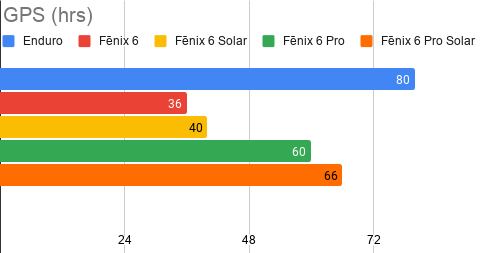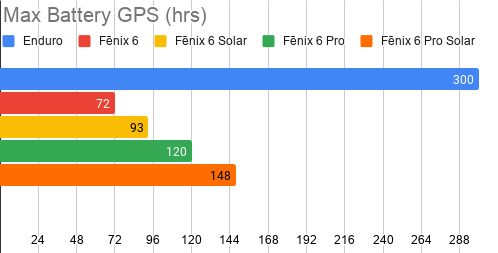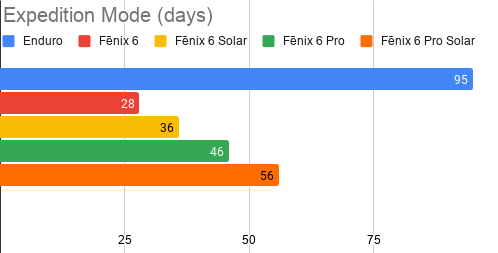Garmin Enduro and Fēnix 6, 6 Pro and solar editions compared
What are the differences between the Garmin Enduro and the Fēnix 6 watches?
With the introduction of the Enduro a lot of discussion has been around what makes it different from a Fēnix 6 or Fēnix 6 Pro. In this article I’ll list the technical specification differences side by side and I’ll explain what these differences mean in real life.
Technical Specifications
These are the *different* technical specifications. If something is not listed they ‘all’ have it, or ‘none’ have it (or it’s so minor that I missed it). I’m not going into all the different colour, size or wrist band variations as that would make this article way too long (the 6 Pro has 28 different options alone), and the chart unreadable. I want to spare you the newspaper size chart.
| Enduro | Fēnix 6 | Fēnix 6 Solar | Fēnix 6 Pro | Fēnix 6 Pro Solar | |
|---|---|---|---|---|---|
| Solar charging | ✅ | ❌ | ✅ | ❌ | ✅ |
| Music Control | ✅ | ✅ | ✅ | ✅ | ✅ |
| Music Storage | ❌ | ❌ | ❌ | ✅ | ✅ |
| Maps | ❌ | ❌ | ❌ | ✅ | ✅ |
| Wifi | ❌ | ❌ | ❌ | ✅ | ✅ |
| PacePro on the fly1 | ❌ | ❌ | ❌ | ✅ | ✅ |
| ClimbPro on the fly1 | ❌ | ❌ | ❌ | ✅ | ✅ |
| Animated Workouts | ❌ | ❌ | ❌ | ✅ | ✅ |
| Screen | 1.4″ | 1.3″ | 1.3″ | 1.3″ | 1.3″ |
| Resolution (px) | 280×280 | 260×260 | 260×260 | 260×260 | 260×260 |
| Storage | 64 MB | 64 MB | 64 MB | 32 GB | 32 GB |
| Enduro | Fēnix 6 | Fēnix 6 Solar | Fēnix 6 Pro | Fēnix 6 Pro Solar |
1) The ClimbPro and Pace Pro require Maps in order to determine it on the fly. If you load a route before your workout, it does work. For all new features introduced with the Enduro, these are (or soon will be) available on the Fenix watches too.
Battery
The main ‘USP’ of the Enduro is the amazing battery life. There are so many factors here that I’ve plotted these out in a separate table. In this table, I’ve taken the declared times with Solar from Garmin for the Enduro. These numbers are a prediction based on the available light and other circumstances (battery age, temperature, etc). You should read these as ‘up to’ in optimal conditions.
| Enduro | Fēnix 6 | Fēnix 6 Solar | Fēnix 6 Pro | Fēnix 6 Pro Solar | |
|---|---|---|---|---|---|
| Smartwatch | 65 days | 14 days | 16 days | 21 days | 24 days |
| Battery saver | 1 year | 48 days | 80 days | 80 days | 120 days |
| GPS | 80 hrs | 36 hrs | 40 hrs | 60 hrs | 66 hrs |
| Max Battery GPS | 300 hrs | 72 hrs | 93 hrs | 120 hrs | 148 hrs |
| Expedition Mode | 95 days | 28 days | 36 days | 46 days | 56 days |
And to visualise, I’ve put the numbers in graphs. The Enduro really is for super endurance.
It should be clear that the Enduro is the winner. By far. Or, as Pierce Hawthorne would say: It’s streets ahead. Considering that the Enduro is using the same housing as the Fēnix 6 watches this is remarkable. Those gains were made by removing some small items (WiFi, storage), making the battery larger and ‘optimising the platform’. The latter is a rather ambiguous statement from Garmin and we can only speculate what it means until we open both up. Since I don’t have $1600 laying around to burn I can only guess. That guess would be: new cpu and and optimised board layout.
Weight
For the weight weenies, it’s interesting to note that the Enduro DLC-titanium is the lightest of all too at 58 grams and 72 grams for the stainless steel edition. The 6 Pro comes in at 83 grams and the Fenix 6 at 85 grams.
Conclusion
Well, in conclusion that’s about it. The Enduro is targeted at the super endurance. You pay more and get a couple features less, but a massive step in battery life. So if you’re really into long-long-long endurance or just hate charging your watch, the Enduro is for you.
Prices
These are the lowest prices I could find on either Garmin, Amazon or Wiggle.







Leave a comment